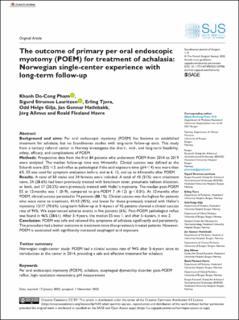| dc.description.abstract | Background and aims: Per oral endoscopic myotomy (POEM) has become an established treatment for achalasia, but no Scandinavian studies with long-term follow-up exist. This study from a tertiary referral center in Norway investigates the short-, mid-, and long-term feasibility, safety, efficacy, and complications of POEM.
Methods: Prospective data from the first 84 patients who underwent POEM from 2014 to 2019 were analyzed. The median follow-up time was 44 months. Clinical success was defined as the Eckardt score (ES) ⩽3, and reflux as pathological if the acid exposure time (pH < 4) was more than 6%. ES was used for symptom evaluation before, and at 6, 12, and up to 64 months after POEM.
Results: A total of 50 males and 34 females were included. A total of 43 (51%) were treatment naïve, 24 (28.6%) had been previously treated with botulinum toxin, pneumatic balloon dilatation, or both, and 17 (20.2%) were previously treated with Heller’s myotomy. The median post-POEM ES at 12 months was 1 (0–9), compared to pre-POEM 7 (4–12) (p < 0.01). At 12 months after POEM, clinical success persisted in 74 patients (88.1%). Clinical success was the highest for patients who were naïve to treatment, 41/43 (95%), and lower for those previously treated with Heller’s myotomy 12/17 (70.6%). Long-term follow-up at 5–6 years of 42 patients showed a clinical success rate of 94%. We experienced adverse events in five patients (6%). Post-POEM pathological reflux was found in 46% (28/61). After 3–4 years, the median ES was 1, and after 5–6 years, it was 2.
Conclusion: POEM was safe and relieved the symptoms of achalasia significantly and persistently. The procedure had a better outcome in treatment naïve than previously treated patients. However, POEM is associated with significantly increased esophageal acid exposure. | en_US |

